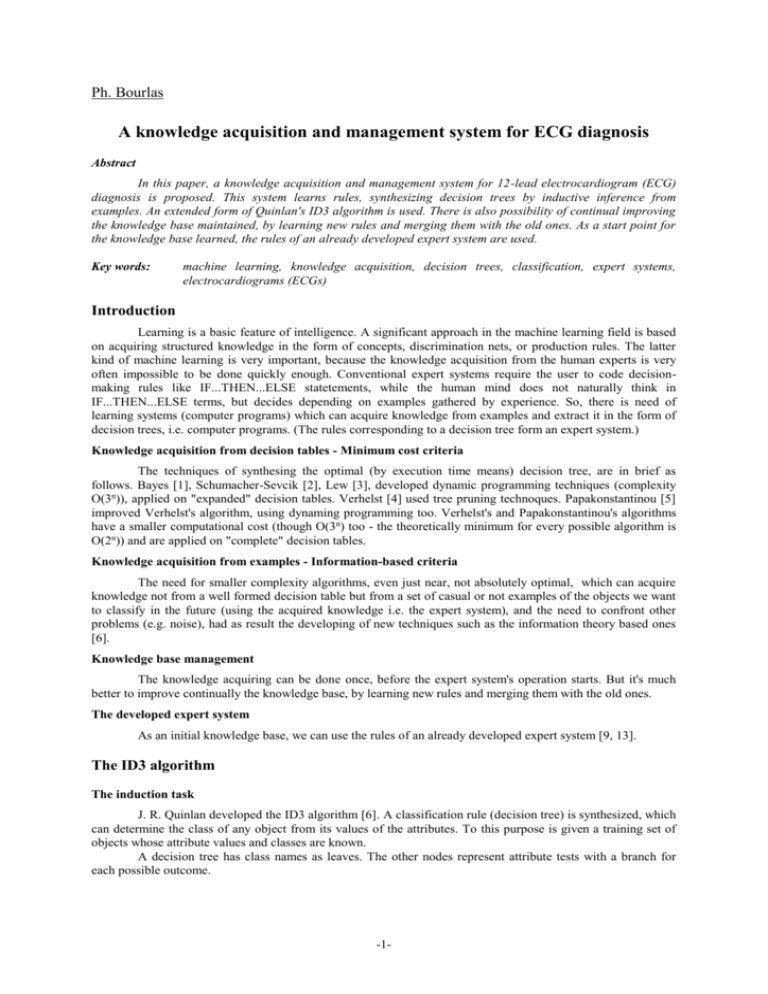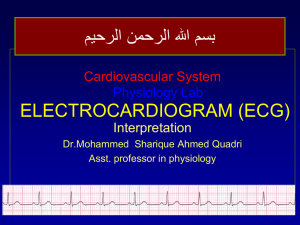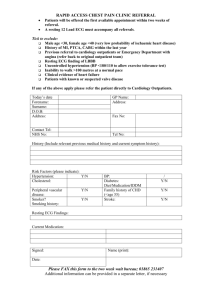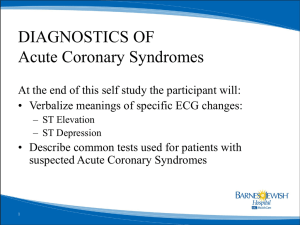A knowledge acquisition and management system for ECG diagnosis
advertisement

Ph. Bourlas
A knowledge acquisition and management system for ECG diagnosis
Abstract
In this paper, a knowledge acquisition and management system for 12-lead electrocardiogram (ECG)
diagnosis is proposed. This system learns rules, synthesizing decision trees by inductive inference from
examples. An extended form of Quinlan's ID3 algorithm is used. There is also possibility of continual improving
the knowledge base maintained, by learning new rules and merging them with the old ones. As a start point for
the knowledge base learned, the rules of an already developed expert system are used.
Key words:
machine learning, knowledge acquisition, decision trees, classification, expert systems,
electrocardiograms (ECGs)
Introduction
Learning is a basic feature of intelligence. A significant approach in the machine learning field is based
on acquiring structured knowledge in the form of concepts, discrimination nets, or production rules. The latter
kind of machine learning is very important, because the knowledge acquisition from the human experts is very
often impossible to be done quickly enough. Conventional expert systems require the user to code decisionmaking rules like IF...THEN...ELSE statetements, while the human mind does not naturally think in
IF...THEN...ELSE terms, but decides depending on examples gathered by experience. So, there is need of
learning systems (computer programs) which can acquire knowledge from examples and extract it in the form of
decision trees, i.e. computer programs. (The rules corresponding to a decision tree form an expert system.)
Knowledge acquisition from decision tables - Minimum cost criteria
The techniques of synthesing the optimal (by execution time means) decision tree, are in brief as
follows. Bayes [1], Schumacher-Sevcik [2], Lew [3], developed dynamic programming techniques (complexity
O(3n)), applied on "expanded" decision tables. Verhelst [4] used tree pruning technoques. Papakonstantinou [5]
improved Verhelst's algorithm, using dynaming programming too. Verhelst's and Papakonstantinou's algorithms
have a smaller computational cost (though O(3n) too - the theoretically minimum for every possible algorithm is
O(2n)) and are applied on "complete" decision tables.
Knowledge acquisition from examples - Information-based criteria
The need for smaller complexity algorithms, even just near, not absolutely optimal, which can acquire
knowledge not from a well formed decision table but from a set of casual or not examples of the objects we want
to classify in the future (using the acquired knowledge i.e. the expert system), and the need to confront other
problems (e.g. noise), had as result the developing of new techniques such as the information theory based ones
[6].
Knowledge base management
The knowledge acquiring can be done once, before the expert system's operation starts. But it's much
better to improve continually the knowledge base, by learning new rules and merging them with the old ones.
The developed expert system
As an initial knowledge base, we can use the rules of an already developed expert system [9, 13].
The ID3 algorithm
The induction task
J. R. Quinlan developed the ID3 algorithm [6]. A classification rule (decision tree) is synthesized, which
can determine the class of any object from its values of the attributes. To this purpose is given a training set of
objects whose attribute values and classes are known.
A decision tree has class names as leaves. The other nodes represent attribute tests with a branch for
each possible outcome.
-1-
The decision tree must classify correctly all the training set objects, and to be sufficiently successful on
other objects classification. In our case (and almost in any case) good is simple. The simplest such tree is that we
are seeking for.
The ID3 algorithm
ID3 doesn't examine all possible trees, because there are usually too many of them. A reasonably good
tree is synthesized, not always the best. A tree for a subset C of the training set is synthesized at first. If this tree
classifies correctly the other training objects too, the procedure has finished. Otherwise some of the not correctly
classified objects are added into C, and the procedure repeats for the new subset.
Synthesizing the tree for C is iterative too. If C= or C contains objects of the same class, the tree is a
leaf with the name of this class. Otherwise an attribute A is selected, with possible values A1,...,Aí, and the tree
has as root the test T of A and as branches the subtrees for the subsets C 1,...,Cí, in which C is partitioned with
regard to its elements values of A.
The selection of attribute A is based on information theory. If there are 2 classes, P and N, and P
contains p elements of C and N contains the rest n elements, the attribute A is selected, the knowledge of the
value of which gives more information gain(A) for the class. It is gain(A)=I(p,n)-E(A), where
p
p
n
n
is the entropy (uncertainty, information average) of the tree for
I( p, n )
log2
log2
pn
pn pn
pn
í
C and E(A )
i 1
pi n i
I( p i , n i ) is the entropy under condition of the tree with given the value of A, where p i
pn
and ni the numbers of the elements of Ci which belong to the classes P and N, respectively. If for k{1,...,í} is
Ck=, the tree for Ck is a leaf, which fails to name a class, or, better, gives to Ck the name of the more frequent
class in C.
The computational complexity of ID3 is polynomial.
Noise
On real world data we often have accidental errors at the attribute values or the class of several objects.
In that case the procedure described above might be problematic, either because of inadequate attributes (two
objects from different classes but with the same attribute values, case in which a tree cannot be found), either
because of synthesizing a tree of greater, spurious complexity to cover the noisy cases.
The second problem is solved if we refrain from testing attributes irrelevant to classification. As a
í
measure of relevance we use the amount
i 1
n 'i n
[
p ni
( p i p 'i )2 (n i n 'i )2
] , where p 'i p i
pn
p 'i
n 'i
and
pi n i
the expected values of pi and ni with the conjecture that A doesn't affect the classification.
pn
For the first problem the better solution seems to be classifying the object to the more frequent class.
Acquiring ECG-diagnosis knowledge using a modified ID3 algorithm
Using an expert system for ECG diagnosis
Many methods have been used for describing the ECG diagnostic criteria [9]. At one end is the
utilization of the natural language and at the other end the utilization of a computer program with built-in
diagnostic criteria. The first approach is suitable for human reading, while the second one for computer reading.
Generally speaking, there are two different approaches to the computerization of the ECG diagnosis. One utilizes
the binary logic as in [10] and the other involves some statistical procedures as in [11]. The binary logic is
usually described in the form of decision tables which provide very clear and compact means for expressing
complex relations.
The NTUA Knowledge Expert system shell [14,15] has been used for the formal description of the ECG
diagnostic criteria, which led to the development of an expert system for the interpretation of the 12-lead ECG
[16]. This approach is suitable for both human and machine reading, offering diagnostic capabilities, interactive
modifications, debugging, explanation and other facilities.
This work started in an effort to formally describe and compare the empiric knowledge used by the
different physicians of the department of Clinical Therapeutics, Alexandra Hospital of Athens. The first effort
was to utilize decision tables. Soon it was clear that this method was not attractive to the medical personnel,
because they had to understand and follow passively complicated decision tables.
-2-
The next effort was to use the M.1 expert system shell [12], describe the knowledge in a form of
English-like rules and let the medical personnel experiment with the expert system developed so far in this way.
By asking "why" and "how" questions, it was possible to find what was wrong in the rules given and make
modifications in a straight-forward way [13]. After the NTUA Knowledge Expert system shell has been
developed by the National Technical University of Athens [14,15], this system has been used to develop an
expert system for the 12-lead ECG interpretation. The reaction of the medical personnel was enthusiastic.
Our intention now is to use the knowledge base of the expert system above as an initial base for the
knowledge acquisition and management system we describe in this paper. The NTUA Knowledge Expert system
shell is going to be used as a shell for running the expert systems learned and management tool for the knowledge
base. But first let's see what has to be done in order to use ID3 algorithm in the ECG diagnosis field.
Extending ID3 algorithm to support more than 2 classes
The classes at our case are all possible diagnoses (rather all that can be done if the values of the specific
ECG attributes are known). As such we can select these of the already developed expert system, but this can be
changed easily in the future.
The information gain criterion of the ID3 algorithm has to be extended, in order to support not only 2
but any number of classes. This can be done as follows. Suppose we have the classes K 1,...,Km and k1,...,km
elements of C belong to K1,...,Km respectively. The attribute A is selected, the knowledge of the value of which
gives
more
information gain(A)
for
the class. It is gain(A)=I(k1,...,km)-E(A), where
m
I( k1,..., k m )
n log
ki
2
i 1
ki
n
is the entropy (uncertainty, information average) of the tree for C (n=k 1+...+km
í
is the number of elements of C) and E(A )
j1
k1 j ... k mj
n
I( k1 j,..., k mj ) is the entropy under condition of the
tree with given the value of A, where k1j,...,kmj the numbers of the elements of Cj (these having the j-th possible
value for attribute A), which belong to the classes K1,...,Km respectively.
Noise
Except the noise from the accidental errors at the measuring of the values af the attributes, or the
accidentaly errors at the given diagnoses of the training ECG samples, it's expected to encounter also inconsistent
samples (same attribute values - different diagnosis), due not to inaccurate attribute values, but perhaps because
the expert system doesn't take care of other important attributes (perhaps difficult to be measured, e.g. patient's
case history). All these cases can be handled using the Quinlan's methods described.
Unknown ECG attribute values
In our case, the better and simpler solution of this problem is, for these attributes of every ECG sample
it's not possible to have an automatic measurement by a computer (automatic ECG recognition is a field where
intensive research has been done and is doing), receive the value from the user. The NTUA Knowledge Expert
system shell offers the interactive features (making questions to the user, making use of run-time variables etc.)
needed [14,15].
ECG classes (diagnoses)
The ECG-diagnosing classes are the following (these are the diagnoses that the already developed
expert system supports):
1.
physiological ECG
2.
3.
4.
5.
6.
7.
8.
9.
incomplete block
complete left block
complete right block
pulmonary embolism
right ventricular hypertrophie
left fore semiblock
left rear semiblock
prinzmetal's angina
10. acute infarction anterior
-3-
11.
12.
13.
14.
15.
16.
17.
18.
19.
20.
21.
22.
23.
24.
25.
26.
27.
28.
29.
30.
31.
32.
33.
34.
35.
36.
chronic infarction anterior
acute infarction oron anterior
acute infarction anterior upper
chronic infarction anterior upper
acute infarction oron anterior upper
acute infarction anterolateral
chronic infarction anterolateral
acute infarction oron anterolateral
acute infarction anterior ekt.
chronic infarction anterior ekt.
acute infarction oron anterior ekt.
acute infarction, no localization
chronic infarction, no localization
acute infarction oron, no localization
acute infarction inferior
chronic infarction inferior
acute infarction oron inferior
acute infarction inferolateral
chronic infarction inferolateral
acute infarction oron inferolateral
acute infarction posterior
chronic infarction posterior
acute infarction oron posterior
acute infarction small anterior with periinfarctic block
chronic infarction small anterior with periinfarctic block
acute infarction oron small anterior with periinfarctic block
37. acute infarction, indeterminate localization
38. chronic infarction, indeterminate localization
39. acute infarction oron, indeterminate localization
40.
41.
42.
43.
44.
45.
46.
47.
48.
49.
50.
51.
52.
53.
left ventricular hypertrophie
chronic ischaemie
acute ischaemie
daktylitis
mixed hypertrophie
acute ischaemie oron
acute ischaemie imeron
myksoedema
perikarditis
vagus hypertonie
hypocalimia
atrial left extension
atrial right extension
right karditis
54. indeterminate diagnosis
ECG attributes
The already developed expert system uses 4 types of attributes; real variables, boolean variables, vectors
of 10 boolean variables, 4-value variables. In order to apply the ID3 algorithm, we transform all variables into
boolean ones. (ID3 supports multi-valued variables, but it's simpler in our case to use only boolean ones.) The
ECG attributes are the following:
Real variables
1. QRS duration
2. QRS axis
These can be transformed, for our purposes, into the following boolean variables:
-4-
1.
2.
3.
4.
5.
6.
7.
QRS duration greater than 0.0987 sec
QRS duration greater than 0.1 sec
QRS duration greater than 0.11982 sec
QRS duration greater than 0.12 sec
QRS axis greater than -45.1o
QRS axis greater than 90o
QRS axis greater than 109.9o
Boolean variables
1. Duration of Q greater than 0.03 sec
2. Existence of ST peak
3. Short ST
4. Sharp T greater than 8 mm
5. T negative with amplitude less 2 mm
6. T negative, isoskeles, with amplitude greater than 2 mm
7. P negative in I
8. Duration of P greater than 0.1 sec
9. Amplitude of P in III greater than 3 mm
10. P axis greater than 75o
11. Positive P greater than negative P, in V1
12. Existence of R in V1
13. Existence of QS in V1
14. Existence of RSR in V1
15. T negative in II
16. T negative in III
17. Amplitude of R less than theamplitude of S, in V1
18. Simultaneous existence of S in I and Q in III
19. T negative in V1, V2, V3
20. Existence of R in III
21. Existence of R in AVF
22. Depth of Q greater than the 1/4 of amplitude of R
23. T negative
24. Amplitude of R in V1 plus depth of S in V5 greater than 40 mm
25. Amplitude of R in V5 greater than 27 mm
26. T negative in V5
27. Peak of ST greater than 1 mm
28. Sum of the amplitudes of RS in I, II, III, less than 15 mm
29. Fall of ST greater than 1 mm
30. Existence of Q in I
Vectors of 10 boolean variables
1. Duration of Q greater than 0.03 sec in each of the leads I, AVL, V1, V2, V3, V4, V5, V6, III, AVF
2. Existence of ST in each of the leads I, AVL, V1, V2, V3, V4, V5, V6, III, AVF
It's obvious that we can transform each of these 10-value vectors into 10 boolean variables.
4-value variable
1. ST shape (regular, angular, board-like, trough-like)
We can transform this 4-value variable into 2 boolean variables, e.g.
1. ST shape is angular or board-like
2. ST shape is angular or trough-like
(No-no is regular, no-yes is trough-like, yes-no is board-like, yes-yes is angular.)
We have therefore 7+30+20+2=59 boolean attributes. This is a relatively big number, but it can be
changed in the future, after further research is done.
Knowledge base management.
-5-
T. Mitchell et al. [7] developed a technique of continual learning. Performance of individual rules is
measured over time, and new learned rules are continually merged and sorted with old ones, based on their
empirically determined accuracy. The system has interactive features; for every new case it advices the user,
using the more succesfull suitable rule of its knowledge base. The user can accept the proposal, or take his own
decision. The system stores the case to be used as a training example for learning new rules. It updates also the
performance statistics for each current rule.
The learning procedure is as follows:
1. Update the performance statistics for each current rule, to include performance on all new training example
ECGs.
2. Window set = the most recent nw training example ECGs.
3. Training set = nt examples selected at random from the window set.
4. Test set = window set minus training set.
5. Learn a decision tree to make an ECG diagnosis, using the ID3 algorithm applied to the training set.
Convert each path of the learned decision tree into a rule.
Remove any rule precondition that do not result in decreased rule performance over either the training set
or test set. (In order to improve generality, rule preconditions are pruned when this improves rule
performance.)
For each new rule, record the number of positive and negative examples it matches from the window set.
Merge new rules into the previous rules, remove duplicates, and sort the list of the rules based on their
measured accuracy.
The system runs this procedure from time to time (if sufficiently enough new ECG examples have been
collected).
For T. Mitcell's learning system [7], it's nw=180 and nt=120. For our ECG diagnosis system these
numbers should be greater (e.g. nw=450 and nt=300) because of the big number of ECG attributes. But the
optimal values for nw and nt as well as the set of ECG attributes that is better to use, are topics where further
research should be done.
In our case, we can take advantage of the NTUA Knowledge Expert system shell interactive features
[14,15]. We can also use as an initial knowledge base the rules of the already available expert system [13,16].
Someone could say that in the ECG diagnosis field there is no need of continual learning, because the
environment isn't changing. (The rules have constant success rate, because the medicine of the subject doesn't
change and at any case doesn't change the specific relation between ECG attribute values and diagnoses.) That is,
if we had a "good" expert system, it would be "good" for ever. A significant problem though is the difficulty of
building such a "good" expert system, because of the complexity of the subject (number of ECG attributes and
classes). There is need of a very large training set, in order to cover so many cases. We can therefore use the
method of continual learning, in order to succeed continual improvement of an initially not so good expert
system.
We have to pay great attention to the size of the training set and to the variety of its elements (ECG
samples). If the training set is very small, the synthesized decision tree hasn’t general power, it’s just a
description of the training set (doesn’t capture structure inherent in the problem, i.e. the meaningful relationship
between an object’s class and its attribute values). (The extreme case is a training set with only one example
element; this element corresponds directly to a rule.) The training set has therefore to be great enough, if we want
to extract simple rules with general power. Using the continual learning technique, we can start with a small
training set, augmented from time to time as more and more ECG samples become available.
At any case, the continual learning technique can be used for merging the available rules from already
developed expert systems [13,16] with the new ones automaticaly learned by examples (that is for continual
improvement of the system) and also for making useful remarks and conclusions by measuring the performance
of the rules over time.
Conclusion and prospects
Machine learning by inductive inference (knowledge acquiring and extracting in a structured form) is feasible
and effective.
The rules learned are intelligible to users and can be continually evaluated.
The expert system learned is useful for providing interactive advice or for educational purposes, but not
sufficiently accurate for autonomous decision-taking. The latter is obvious for applications related with the
human health.
-6-
The performance measurement of every rule and the continual merging of new rules to old ones is feasible
and effective.
The great complexity of the ECG (number of attributes and classes) has as result the need of further research
in order to improve the system described.
Topics where further research can be done:
ECG attributes used. One would like the learning system to consider all attributes possible in its search for
general rules. However, as one increases the number of attributes one must also increase the number of
training examples in order to maintain a fixed level of learning performance (more data is required to select
reliably among the larger set of candidate hypotheses). Perhaps a method like R. Caruana's "greedy attribute
selection" [8] that selects automatically which attributes to use for future learning by determining which
attributes would have led to the most succssful learning in the past, could be used.
ECG classes (diagnoses) used.
Attribute selection criterion.
Further modification of the ID3 algorithm, in order to support real-value attributes.
Further improvement of the algorithms used.
Any further improvement and refinement.
References
[1] A.J. Bayes, "A dynamic programming algorithm to optimize decision table code", Australian Computer. J. 5,
2, pp. 77-79, 1973.
[2] H. Schumacher, K.C. Sevcik, "The synthetic approach to decision table conversion", Communications of the
ACM, Vol. 19, No. 6, June 1976.
[3] A. Lew, "Optimal Conversion of extended-entry decision tabbles with general cost criteria", Communications
of the ACM, Vol. 21, No. 4, April 1978.
[4] M. Verhelst, "The conversion of limited-entry decision tables to optimal and near-optimal flowcharts: Two
new algorithms", Communications of the ACM, Vol. 15, Number 11, pp. 974-980, Nov. 1972.
[5] G. Papakonstantinou, "A recursive algorithm for the optimal conversion of decision tables", Angewandte
Informatik, Vol. 22, No. 9, pp. 350-354, 1980.
[6] J. R. Quinlan, "Induction of decision trees", Machine Learning 1, pp.81-106, 1986.
[7] T. Mitchell, R. Caruana, D. Freitag, J. McDermott, D. Zabowski, "Experience with a learning personal
assistant", Communications of the ACM, Vol. 37, No. 7, July 1994.
[8] R. Caruana, D. Freitag, "Greedy attribute selection", Proceedings of the 11th International Conference on
Machine Learning, July 1994.
[9] J. Willems, "Common standards for quantitative electrocardiography" J. Med. Eng. Techn. 9: 209-217, 1985.
[10] J. Wartak et al., "Computer program for diagnostic evaluation of Electrocardiograms", Computer
Biomedical Research 4: 225-238, 1971.
[11] M. Laks et al., "Computer linkage of the clinical history to electrocardiographic language permitting the use
of Bayes' theorem", Proc. Computer in Cardiology, Boston 1986.
[12] "M.1 reference manual (version 1.3)", Framentec SA., 1986.
[13] E. Giakoumakis et al., "Formalization of the ECG diagnostic criteria using an expert system shell", Proc.
Computer in Cardiology, IEEE, 1988.
[14] K. Flokos, "NTUA Knowledge Expert", Diploma Thesis, National Technical University of Athens, 1990.
-7-
[15] NTUA, "The NTUA Knowledge Expert users manual (version 1.1)", National Technical University of
Athens, 1991.
[16] Ph. Bourlas, E. Giakoumakis, D. Koutsouris, G. Papakonstantinou, P. Tsanakas, "The Cardio-Logos system
for ECG training and diagnosis", Accepted in Technology and Health Care, Elsevier Science B.V., 1995.
-8-








